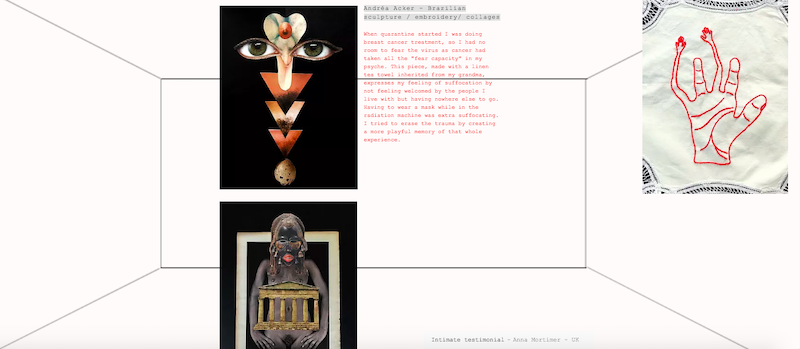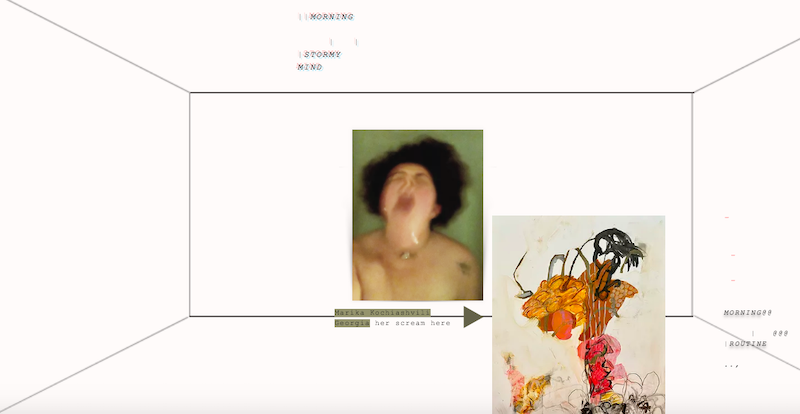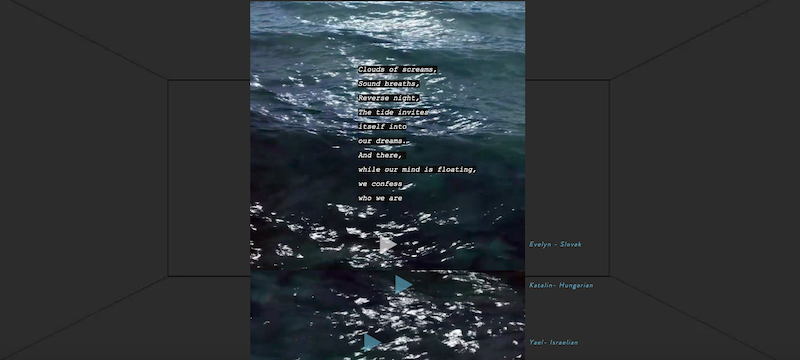by Aoife Donnellan // Mar. 8, 2021
Heroines Wave is an organisation dedicated to fostering interdisciplinary collaboration between women, focusing on the topic of intimacy, through exhibition and research. Usually Heroines Wave hosts an art residency for its participants, where they create work alongside one another, as well as a program of talks and the final exhibition but this year, as a result of the lockdown, their annual exhibition appears online. Speaking with curator and founder Célia Stroom and communication manager Annina Lehmann about the digital exhibition ‘Enclosed Garden #2’, they explain the intentions behind the project as well as how they created their digital platform.
‘Enclosed Garden #2’ is a digital exhibition and dialogue between 31 women from 23 countries, all of whom have created work in response to the Coronavirus lockdown implemented by their local governments. The Heroines Wave digital platform is successful in capturing the relationship between works that is often missing from other online exhibitions. It includes photography, poetry, sound recordings, drawings, music and film, among other disciplines.

Heroines Wave: ‘The Enclosed Garden #2’, 2020 // Courtesy of the artist and Heroines Wave
Aoife Donnellan: What inspired you to found Heroines and begin ‘The Enclosed Garden’ series of exhibitions?
Célia Stroom: At the very beginning, I was working with a group of women artists and we had this feeling that when you have a collective exhibition, actually the artists are not really invited to work together. Then, as a curator, everytime I worked for museums I was really bored by this concept of the white cube everywhere, and so I really wanted to create a kind of labyrinth in the exhibition where you have artworks everywhere. Usually we organise physical exhibitions, not online exhibitions, so this one is the first digital one because of the pandemic.
The idea was to change the rules of the exhibitions: why are exhibitions always organised in the same way? Why aren’t audiences invited to meet the artist? Usually when you go to an exhibition you just have the artworks on the wall, or in the space. Also, why are most exhibitions only viewable during the day? Through our exhibitions we want to create intimate connections between the audience and the artist, so we decided to organise our exhibitions only during the night. To create an intimate atmosphere, we changed all the rules.
We put artworks everywhere, when it is a physical exhibition, and so when it went online, we tried to recreate that by overwhelming the audience. You have to be overwhelmed by the text, the pictures, the video. It has to be everywhere. For the online exhibition we tried to help people to feel intimate with the artworks, that’s why we ask them to dive into the website, during the night or early in the morning, to be alone in front of their computer, to take their time to relax, maybe to have a drink.
AD: The materiality of the project feels like a physical exhibition in terms of how the sounds and visuals can bleed together, and how each element exists in relation to another—something that is often overlooked in digital exhibitions. How did you arrive at this format? Can you say more about the design of the exhibition and how it came about?
Annina Lehmann: In reference to what you said about the collaborative aspect, it happens in the process of creating the exhibition. In the physical ones much more, because everybody lives together, so it is not just people arriving and presenting, there is a sort of real community aspect to the creation. Creating together, even though everybody has their own project, is something that really comes across in the online exhibition because everything has a sort of dialogue in the way that we designed it. As you said, it’s not just one artwork and another one, there is a conversation happening. I think it’s important that it is both present in the process and in the experience of the audience.
CS: We really tried to create a tapestry, or we tried to weave all the dialogues through each other, and not to have individual artists. Actually, we are totally against individualism in contemporary art; it’s about ego and having a solo show. We are all artists in this collective, and we cannot bear anymore of this behaviour. We want to create movements. At the beginning of the 20th century, you would have a lot of artistic movements, and there is a reason they disappeared because now we have been raised as individuals with huge egos. We are really trying, in our exhibition, both online and physically, to create strong bonds between people. The artist will never forget this experience, and the audience will never forget this experience. That is what we try to do.
When you create an online exhibition you basically put images or text or videos, one after another. For the design of the website, I am a web designer, I designed the platform, and I really wanted the artist to be in the same room. When we received all of these intimate testimonials in our inbox, we were super moved, on the team. We are four curators from different countries, and everyday we would receive new emails from women, we had like 300 women who replied, and every time they would speak about their intimate stories, their trauma, the way they want to scream because nobody is listening to them. Of course, then you cannot create an online exhibition where people are not discussing with one another.

Heroines Wave: ‘The Enclosed Garden #2’, 2020 // Courtesy of the artist and Heroines Wave
AD: The exhibition features lots of moments of recognition including the difficulties of domesticity and communicating with friends while in lockdown. Why does Heroines focus on intimacy as a theme throughout?
CS: People are distant in our society. People are selfish, and when you go to an exhibition there is no intimacy, you just take a picture for Instagram and then you leave the space, and you don’t actually remember the exhibition after a few months. What is the point of that?
We have this feeling right now that when you are a contemporary artist you have to be fake, if you want to be successful. You have to show up, and here, in this kind of exhibition, we just say to the artist, “Really say whatever you want to say, here there will be no judgement.” In our exhibition, we really want to enhance this idea that you come with your ideas, and you try to be sincere.
AL: I think that is related to what you were saying about the pressure of marketing yourself in the artwork: the capitalist branding. And you have to fight for yourself, to present something and represent yourself. I think the collective form allows for much more vulnerability and trust that is created through this experience, through the offer to share a space. I think that is really important today, to go against the idea of being so conscious of how other people perceive you, it creates a wall and armour that people wear. I think it is quite amazing how the exhibition manages to take this away and to allow people to express something that is quite difficult to express.

Heroines Wave: ‘The Enclosed Garden #2’, 2020 // Courtesy of the artist and Heroines Wave
AD: At the beginning of room 2 you have a black square for people to see themselves in, reaffirming the ways in which technology is at the centre of this exhibition. Has the digital format affected the contents of the exhibition?
CS: In the call we wrote that you can only apply with the artworks that you have been creating the last two months, even sketches or just a text. If you are a painter, but you don’t paint anymore because you are too depressed, maybe you write something in your notebook, and you can share this. We really think that you are an artist not only because you paint, but because you write, because you cook, because you make love. I mean, you are an artist beyond your artistic object. We are looking for true expressions; no matter if it is just a sketch, or just a vocal recording on your iPhone, because everything is creative. As soon as we feel it is sincere, we can select it.
AL: The idea is also to connect professional artists to women for whom making art is not their main job. They do other things, but they are also artists so we try to scratch at this image of what makes an artist. Do you have to be commercially successful in order to be an artist? This was the idea, before the pandemic, but I wonder if the online exhibition opened it up even more, because it was so international.
CS: The interesting thing is that we had women applying from 60 countries, and the trauma of being isolated is really the same, no matter the country, cultural or social background. We had a woman from Nepal saying the same thing as a woman from New York.
There were four curators, one from Georgia, one from Thailand, and two from France. We worked on a voluntary basis because we just wanted to do something. It was two full months of work. Sometimes, at Heroines Wave, we think we need to work for free to help others, that is one really important part of our project. With corona, we receive less money, so what do we do? We stop working for others. The idea of Heroines Wave is to have a network of women who can help each other.




















